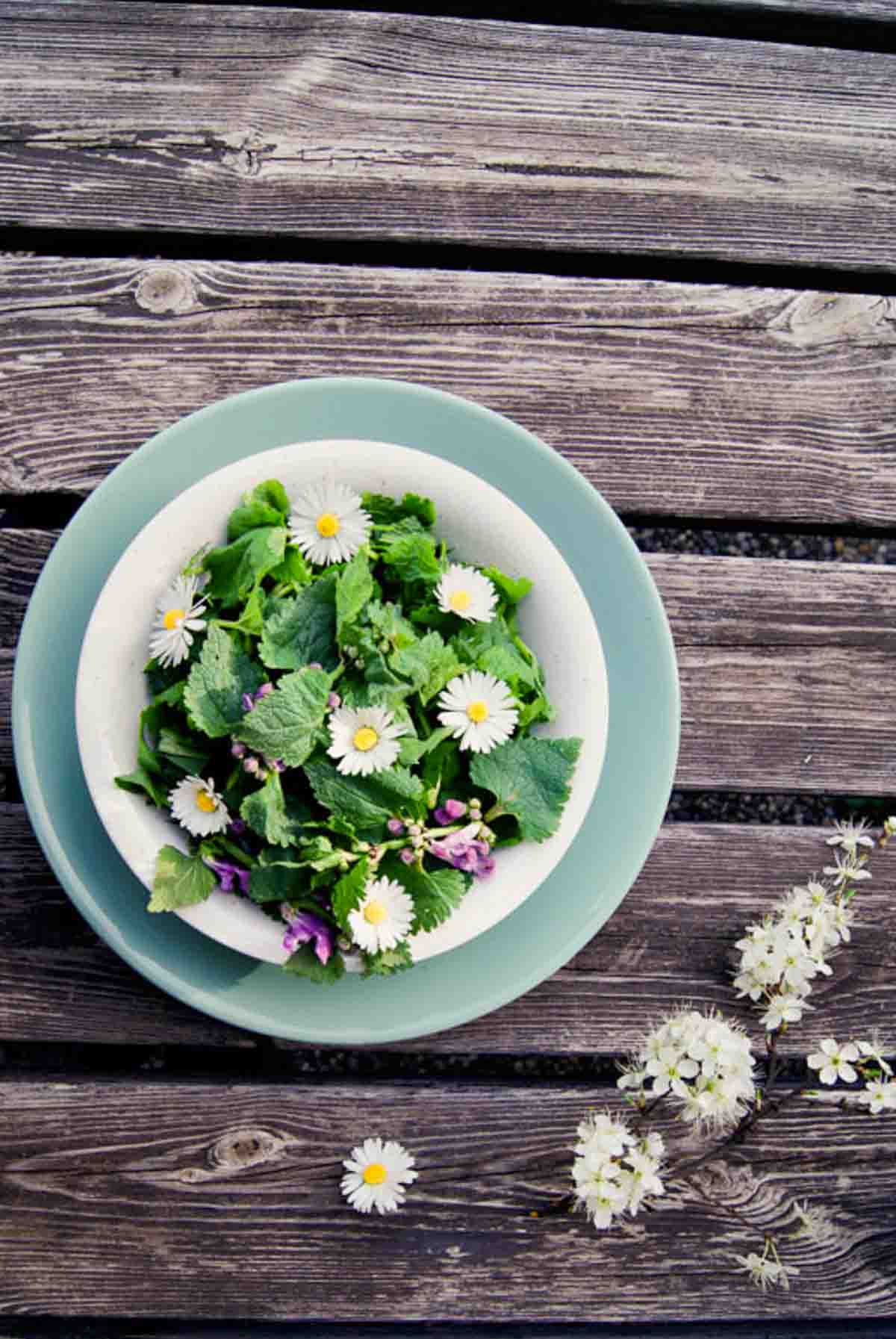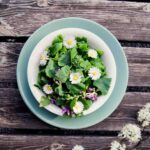Right now in spring is the perfect time to pick your own healthy free salad from nettles and other wild herbs. This recipe provides a quick and easy stinging nettle salad with apple cider vinegar, honey and olive oil.
In the post below, there is information for gathering and processing stinging nettles and wild herbs in general.

Jump to:
How to harvest Stinging Nettle
The best time to collect nettle for salad is in May, when the plant has already grown large, but the shoots are still young. If you don't like it so bitter, you should harvest only the tips (that is, the top 5cm of the plant). The young shoots of the plant are less bitter than the large lower leaves.
For tea, wild herb spinach and similar dishes where nettle is cooked, you can also harvest the older and larger leaves well into early fall. (But of course, this is also a matter of taste, depending on how bitter you like it).
For collecting nettles you should use gloves (e.g. cleaning gloves or gardening gloves).
The seeds of nettles are also edible and very healthy! (Approx. from September to harvest)
How to Cook with Stinging Nettle
To prevent nettles from causing a burning sensation when eaten raw, you can wrap them in a cloth and knead or "wuzz" the cloth thoroughly. This breaks down the structure that causes the burning sensation. Afterwards, you can cut them into small pieces.
Boiling (or briefly blanching) and sautéing also removes the stinging effect of the nettle.
Stinging nettle can be used in cooking as a substitute for spinach, leafy greens, or other wild herbs. It's great in strudels, soups, spreads, and more.
Nettle seeds can be used like sesame or sunflower seeds, once they are dried. Use them in muesli, bread, toppings for salads and spreads, and more.
General information for collecting wild herbs
Before collecting wild herbs in general, please make sure that no poisonous doppelgangers have been picked! Yarrow, for example, can be confused with poisonous tansy or hemlock if it has not yet formed the typical flowers.
There are lots of online encyclopedias, books and apps on this subject.
Here is the link to a Wild Foraging Guide by woodlandtrust.org.uk.
I like to use the (paid) App "PictureThis": When you want to know what plant you have in front of you, you just take a picture with the app. It scans the picture and tells you the name, if its poisonous, etc. And so far the app worked really well!
In principle, the younger shoots and leaves are always less bitter and taste more delicate.
It is best to pick your wild herb meal in meadows that are not so heavily polluted with exhaust fumes. (So better not in inner-city parks or green spaces).

Stinging Nettle Salad
Zutaten
- 2 handfull stinging nettles leaves (the leaves of the top 5cm of the plant)
- 2 handfull dandelion greens the younger leaves
- 1 handfull daisy flowers
- 4 tbsp. apple vinegar
- 1 tbsp. honey
- 4 tbsp. olive oil
- 1 pinch salt
- fruit or berries to taste
Anleitung
- Wash nettles, wrap in a dishtowel and knead well, so that they no longer burn. Cut the nettles small.Wash daisy flowers and put away the stems. Wash and chop dandelion leaves and flowers
- In the salad bowl, mix the vinegar with about ½ cup {100 ml} of water, add salt and honey and mix until both have dissolved.
- Add the wild herbs to the vinegar mix in the bowl and mix well with the olive oil, eventually add some more salt and pepper.
(c) by Angelika Kreitner-Beretits / Vienna Sunday Kitchen
April 29, 2023 Hast du das Rezept ausprobiert? Dann freue ich mich über deine Bewertung!! / Rate this Recipe!
Ich freu mich über deine Rückmeldung zum Rezept in den Kommentaren!